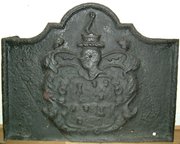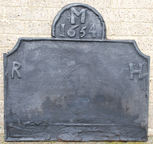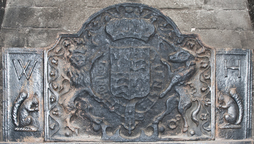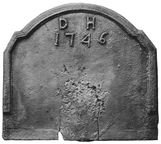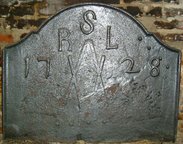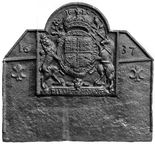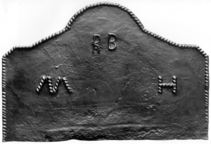-
932
Description: Carved wooden fireback pattern. Canted arched rectangular shape with cavetto-moulded astragal edging; coronet in arch; oval shield with a crowned lion lion rampant, supported two griffons reguardant, the whole within a cartouche, the bottom of which terminates in two swirls between which is a human mask.
Notes: Theodore Agrippa d'Aubigné
Arms: Theodore Agrippa d'Aubigné
- Decoration tags:
- rectangular with canted top corners and round arch (shape)
- astragal with cavetto (edging)
- whole carved pattern
- planklines
- armorial
Manufactured: in the early-17th century in France.
Current location: not known.
Citation: Carpentier, H., 1912, Plaques de Cheminées (Paris, published by the author).
- Attached to series:
- Patterns
- Personal armorial firebacks
-
16
Description: Arched rectangular shape cut away with symmetrical concave curves; ovolo moulding (top and sides); shield, helmet, crest and mantling of the family of Baker, of Mayfield, quartered with Farnden, of Sedlescombe: Quarterly, 1st and 4th, Argent, a tower between three keys erect sable (Baker); 2nd and 3rd, Purpure, a chevron vairy Or and gules, between three leopards’ faces Or (Farnden). Crest (Baker): on a tower sable an arm embowed in mail holding in the hand a flint-stone proper.
Notes: A carved armorial on a plain, edged base board; John Baker (1644-1723) married Ruth, daughter and co-heiress of Peter Farnden, in 1663; she died in 1691, thereafter the arms of Baker quartered those of Farnden; the arms of Farnden had been granted in 1634. The armorial design has been inadequately pressed into the sand bed.
Copies of this fireback are known.
Arms: Baker, of Mayfield, quartering Farnden, of Sedlescombe
- Decoration tags:
- rectangular with canted top corners and round arch (shape)
- ovolo (edging)
- carved pattern panels
- armorial
Manufactured: in the early- to mid-18th century possibly at Heathfield Furnace in the Weald area of England.
Current location: Battle Museum of Local History, Battle, East Sussex, England.
- Attached to series:
- Personal armorial firebacks
- Ironmasters armorial series
-
878
Description: Cavetto-canted arched rectangle; twisted rope edging, separately around rectangle and arch; initials 'R' and 'H' in upper left and right corners of rectangle; 'M' above date in arch.
Notes: The arch does not appear to have been a separate stamp, although the rope edging gives that impression; the initials, in triad, suggest a husband and wife - R.. and H.. M..
Inscription: M / 1654 / / R H
- Decoration tags:
- rectangular with canted top corners and round arch (shape)
- rope (edging)
- simple stamps
- carved stamps
- individual letters
- individual numbers
- text
Manufactured: in 1654 possibly in the Weald area of England.
Current location: in private hands, Birling, Kent, England.
- Attached to series:
- Date & initials firebacks
-
1244
Description: Cavetto-canted arched rectangular shape with rectangular extension panels; cavetto-moulded edging, with astragal on wide fillet edging on the extension panels; central panel, crown, shield and Garter of the Tudor royal arms but with crowned lion and unicorn supporters, all within an undulating vine border; extension panels comprise a single letter (W on left, H on right) above an inward-facing seated squirrel.
Notes: The royal arms are a hybrid of the Tudor and Stuart achievement, quite crudely modelled. The initials and squirrels both relate to the Holte family who lived at Aston Hall, which was built between 1618 and 1623. The difference in the condition of the armorial and the extensions suggest that the armorial was significantly older than the extensions. The bottom 190mm of the fireback is concealed below, behind the grate placed in front of it.
Inscription: W / HONY SOIT QUI MAL Y PENSE / H
Arms: English Tudor royal with Stuart lion and unicorn supporters
- Decoration tags:
- rectangular with canted top corners and round arch (shape)
- cavetto (edging)
- carved stamps
- carved pattern panels
- extension panels
- heraldic
- armorial
- royal
- text
- animals
Manufactured: in the mid- to late-17th century in England.
Current location: Aston Hall, Aston, West Midlands, England.
(part of the Birmingham Museums Trust museum group)
- Attached to series:
- Stuart royal armorial firebacks
-
999
Description: Arched rectangular shape with cyma recta shoulders; astragal edging (top and sides); top centred, date split by a mirrored 'TC' monogram.
Notes: A bold, simple design, its dimensions reflecting the reduced size of fireplaces in the period.
Inscription: 16 TCTC 93
- Decoration tags:
- rectangular with canted top corners and round arch (shape)
- astragal (edging)
- carved stamps
- individual numbers
- monogram
- text
Manufactured: in 1693 in England.
Current location: Ashmolean Museum Broadway, 65 High Street , Broadway, Worcestershire, England.
(part of the Ashmolean Museum museum group)
- Attached to series:
- Date & initials firebacks
-
239
Description: Arched rectangle with stepped, canted shoulders; fillet and astragal edging (top and sides only); initials above date at top of plate.
Notes: The shape and edging are uncommon. Formerly from Caerphilly, Glamorgan.
Inscription: D H / 1746
- Decoration tags:
- rectangular with canted top corners and round arch (shape)
- fillet (edging)
- individual letters
- individual numbers
- text
Manufactured: in 1746 in Wales.
Current location: National History Museum, St Fagans, Glamorgan, Wales.
Museum number: 44.303/1 (part of the Welsh National History Museum museum group)
- Attached to series:
- Date & initials firebacks
-
39
Description: Quasi-arched rectangular shaped with cavetto canted top corners; fillet edging; two V-shaped arrangements of laths, one inverted and superimposed over the other, in centre of plate; date split on either side; initials in triangular arrangement above laths.
Notes: The shape of the fireback is very similar to firebacks at Knole, Sevenoaks, of similar date, and may be the product of the same furnace; the 'X' shapes may have apotropaic significance.
Inscription: 17 RSL 28
- Decoration tags:
- rectangular with canted top corners and round arch (shape)
- fillet (edging)
- simple stamps
- individual letters
- individual numbers
- apotropaic
- text
- objects
Manufactured: in 1728 in the Weald area of England.
Current location: Cranbrook Museum, Cranbrook, Kent, England.
- Attached to series:
- Date & initials firebacks
-
955
Description: Composite; canted arched rectangular shape; armorial fireback, cavetto edging, with Stuart Royal arms, garter, supporters, crown and motto, and 1620 date above crown; this overlies a canted rectangular plate, with twisted rope edging, fillet; two quasi-horizontal fillets from the tops of the vertical sides to the middle of the armorial fireback separate the back into two uneven parts, the date in the top part, split by the armorial, and a fleur-de-lys at the top of the lower part, also separated by the armorial.
Notes: The use of the armorial back is seen frequently and probably dates from 1619, though the date is usually altered; in this case the alteration does not match the more prominent date for the fireback; photograph ex T. Crowther & Son Ltd, 1985.
Inscription: 16 29 / HONI SOIT QUI MAL Y PENSE / 16 37 / DIEV ET MON DROIT
Arms: English Stuart royal
- Decoration tags:
- rectangular with canted top corners and round arch (shape)
- rope (edging)
- carved stamps
- whole carved pattern
- composite
- individual numbers
- heraldic
- armorial
- royal
- text
Manufactured: in 1637 possibly in the Forest of Dean area of England.
Current location: not known.
-
1024
Description: Canted rectangular shape with canted arch; probable twisted leather edging (top and sides); top centre, initials RB formed of individual carved letters; centre, widely spaced, letters M H formed of short lengths of probable twisted leather.
Notes: An unusually shaped fireback
Inscription: RB / M H
- Decoration tags:
- rectangular with canted top corners and round arch (shape)
- twisted leather (edging)
- simple stamps
- carved stamps
- individual letters
- text
Manufactured: in the early- to mid-17th century in England.
Current location: not known.
- Attached to series:
- Initials only firebacks
-
1132
Description: Cavetto-canted arched rectangular shape; rebated wide fillet edging; shield of Llewellyn impaling unidentified arms: (Llewellyn) Per fesse embattled, azure and or, a javelin erect, between two boars' heads erased in chief, and a like boar's head between two javelins in base, all counterchanged; below, scroll bearing the motto, Gwell angau na Chywilydd (Death before Dishonour), possibly inscribed after casting.
Notes: The arms were granted to Robert William Llewellyn of Court Colman and Baglan Hall, Glamorgan, in 1902.
Inscription: Gwell angau na Chywilydd {Better death than shame]
Arms: Llewellyn, of Court Colman, Glamorgan
- Decoration tags:
- rectangular with canted top corners and round arch (shape)
- fillet (edging)
- whole carved pattern
- heraldic
- armorial
- text
Manufactured: in the early-20th century in Wales.
Current location: Gallops Architectural, Ty-r-Ash, Brecon Road, Crickhowell, Powys, Wales.
- Attached to series:
- Personal armorial firebacks
 carpentier p229 690x870.png)
